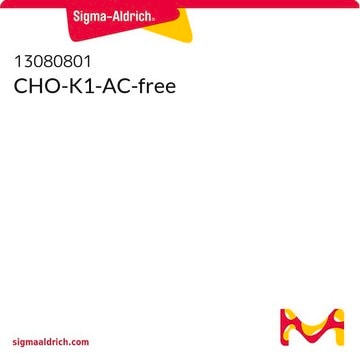A general guideline for the approximate number of cells per square centimeter in a 100% confluent flask is 1 x 10^5 cells/cm². For more detailed information, refer to the table on page 4 of the following brochure: https://www.sigmaaldrich.com/deepweb/assets/sigmaaldrich/marketing/global/documents/318/066/corning_cc_guide.pdf
CHO-K1 Cell Line from hamster
NOTE: Both the cell line and DNA from the cell line may be available for this product. Please choose -1VL or VIAL for cells, or -DNA-5UG for DNA, 85051005, hamster ovary, Epithelial
Synonyme(s) :
CHO cell clone K1 Cells, CHOK1 Cells
About This Item
Produits recommandés
Source biologique
hamster ovary
Conditionnement
tube of 5 μg 85051005-DNA-5UG
pkg of vial of cells 85051005-1VL
Mode de croissance
Adherent
Caryotype
Hypodiploid, modal no. 20
Morphologie
Epithelial
Produits
Not specified
Récepteurs
Not specified
Technique(s)
cell culture | mammalian: suitable
Conditions d'expédition
dry ice
Température de stockage
−196°C
Origine de la lignée cellulaire
Description de la lignée cellulaire
Application
Procédure de repiquage
Autres remarques
Produit(s) apparenté(s)
Faites votre choix parmi les versions les plus récentes :
Certificats d'analyse (COA)
It looks like we've run into a problem, but you can still download Certificates of Analysis from our Documents section.
Si vous avez besoin d'assistance, veuillez contacter Service Clients
Déjà en possession de ce produit ?
Retrouvez la documentation relative aux produits que vous avez récemment achetés dans la Bibliothèque de documents.
Articles
Eukaryotic cell lines aid in complex post-translational modifications and folding of recombinant proteins. Find suitable recombinant protein production cell lines.
-
What is the approximate cells/cm2 of a 100% Confluent flask?
1 answer-
Helpful?
-
-
Is the cell like deficient of DHFR gene?
1 answer-
CHO-K1 are dihydrofolate reductase (DHFR) positive. There are other mutants made from CHO-K1 that are DHFR deficient. Please see the links below to review these possible options:
CHO/dhFr-
https://www.sigmaaldrich.com/product/sigma/cb_94060607CHO/dhFr-AC-free
https://www.sigmaaldrich.com/product/sigma/cb_05011002CHOZN® ZFN-Modified CHO
https://www.sigmaaldrich.com/product/sigma/chodhfrHelpful?
-
-
What medium should I use when I thaw the Cell Line cells?
1 answer-
The medium for each cell line is listed on the product page. It is specific to each cell line. If not visible on the Sigma-Aldrich website product page, the HPA website also contains the same information (www.hpacultures.org.uk). The product number for the cell line is the same on either site.
Helpful?
-
-
How do I handle Cell Line frozen cells upon arrival?
1 answer-
Upon receipt, frozen ampules should be transferred directly to vapor phase liquid nitrogen without delay (-135°C) or liquid phase liquid nitrogen if vapor phase is not available. DO NOT use a -80°C freezer as an alternative; this will result in loss of viability.
Helpful?
-
-
How many Cell Line cells are in the vial?
1 answer-
Each vial of cells contains 2-3 x 106 cells in 1 ml of freezing media. This is in a 1.8 mL ampule. For exceptionally large cells, counts may decrease. Suspension cells, generally smaller cells, may contain as many as 4-5 x 106 cells/vial to assure optimal viability upon thaw.
Helpful?
-
-
What passage are my Cell Line cells?
1 answer-
If the passage of the cells is known, it is listed on the product page at the HPA website (www.hpacultures.org.uk).
Helpful?
-
-
Are my Cell Line cells mycoplasma tested?
1 answer-
ECACC routinely tests all manufactured cell banks for mycoplasma.
Helpful?
-
-
Why is Vapor Phase Liquid Nitrogen preferred for storage of Cell Line cells?
1 answer-
If ampules are immersed into liquid phase of liquid nitrogen, it increases the risk of the liquid seeping into the vial. This could lead to problems of cross-contamination and increased risk of the ampule exploding when thawed.
Helpful?
-
-
Are the Cell Line cells tested for viral pathogens?
1 answer-
HPA Cultures does not perform any viral testing on the cell lines.
Helpful?
-
Active Filters
Notre équipe de scientifiques dispose d'une expérience dans tous les secteurs de la recherche, notamment en sciences de la vie, science des matériaux, synthèse chimique, chromatographie, analyse et dans de nombreux autres domaines..
Contacter notre Service technique






